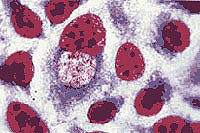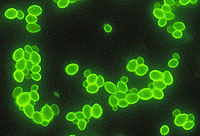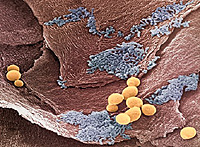In its properties, chlamydia occupy an intermediate position between viruses and bacteria. Therefore, so far chlamydia is diagnosed and treated with great difficulty than ordinary bacterial infections.
Content
 Urogenital chlamydia refers to sexually transmitted diseases. Often there is a combination of chlamydia with other urinary infections - trichomoniasis, gardnerellosis, ureaplasmosis.
Urogenital chlamydia refers to sexually transmitted diseases. Often there is a combination of chlamydia with other urinary infections - trichomoniasis, gardnerellosis, ureaplasmosis.
The incubation period (when the infection has already happened, but there are no signs of the disease yet) during chlamydia is approximately 1-3 weeks. Featured chlamydia notes characteristic vitreous discharge from the urethra in the morning. Itching itching or unpleasant sensation when urination, sticking of sponges of the outer hole of the urethra. Sometimes the general condition is suffering - weakness is noted, the body temperature slightly increases.
It should be noted that chlamydia often proceeds without pronounced signs, or does not appear in any way. Even without treatment after a while (about 2 weeks), the symptoms of the disease disappear. Chlamydia at the same time acquires a chronic course, chlamydial infection as if «Canning» in the body, waiting for the chance to recall them again.
The main danger of chlamydia is precisely in those complications that it can cause. After some time chlamydia «Get» to prostate gland and seed bubbles, causing chronic prostatitis and vesiculitis. Next, the chronic process extends to the appendage of eggs, which can lead to the obtuctive (caused by the obstruction of the seedy ways) form of male infertility.
Chlamydia can also get into the wall of the bladder and cause hemorrhagic cystitis. Chronic inflammation of the urethra caused by chlamydia leads to the development of its narrowing (stricture).
In women, chlamydial infection often causes obstruction of phallopy pipes, ectopic pregnancy, postpartum or post-charge endometrite. Pregnancy in patient chlamydia often proceeds with complications.
In addition to various complications relating to genital organs, chlamydia can cause the defeat of other organs. Then this disease will already be called a disease, or Reiter syndrome. In the Reiter syndrome, the eyes may be affected (chlamydial conjunctivitis), joints (more often ankle, knee and spine), leather, internal organs (more often hepatitis, but almost any organs may be affected).
Diagnosis of chlamydia is more complex than bacterial infection. The simplest methods have accuracy of no more than 40%. The most accurate and affordable method of determining chlamydia in a separated from the urethra today is the immunofluorescence response (reef) using antibodies labeled with a special substance - Fitz.
Due to the characteristics of chlamydia, antibacterial drugs against them are not as effective as against ordinary bacteria, so treatment of chlamydia is more complex and time consuming. In addition to the course of antibacterial therapy, it necessarily includes immunomodulatory therapy, polyvitaminotherapy, lifestyle normalization, diet, rejection of sexual life during treatment.
Treatment must be carried out to all partners. At the end of the course are conducted test analyzes. If chlamydia is not detected, then analyzes are carried out 2 more times after 1 month (in women - before menstruation). Only after that it will be possible to talk about the effectiveness of the therapy.
How to protect yourself and partner?
About chlamydia with confidence it can be said that it is much easier to avoid to cure. Therefore, once again we give the rules of hygiene of sexual life, which will protect you from various sexually transmitted diseases:









